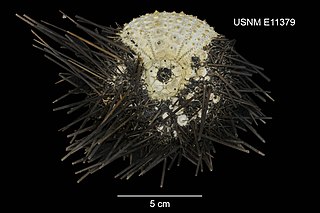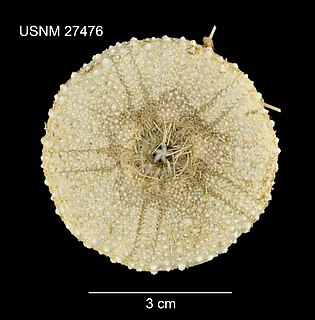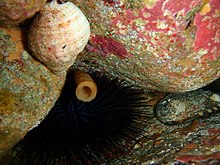
The Diadematidae are a family of sea urchins. Their tests are either rigid or flexible and their spines are long and hollow.
Ammotrophus platyterus is a species of sand dollar of the family Clypeasteridae. Their armour is covered with spines. It came from the genus Ammotrophus and lives in the sea. Ammotrophus platyterus was first scientifically described in 1928 by Hubert Clark.
Anametalia regularis is a species of sea urchin of the family Brissidae. Their armour is covered with spines. It is placed in the genus Anametalia and lives in the sea. Anametalia regularis was first scientifically described in 1925 by Hubert Clark.
Aporocidaris fragilis is a species of sea urchin of the family Ctenocidaridae. It is well-armoured with spines. It is placed in the genus Aporocidaris and lives in the sea. Aporocidaris fragilis was first scientifically described in 1907 by Alexander Emanuel Agassiz & Hubert Lyman Clark.
Araeosoma paucispinum is a species of sea urchin of the family Echinothuriidae. Their armour is covered with spines. It is placed in the genus Araeosoma and lives in the sea. Araeosoma paucispinum was first scientifically described in 1924 by Hubert Lyman Clark, an American zoologist.

Araeosoma thetidis is a species of sea urchin of the family Echinothuriidae. This species can be found in deep sea off Australia and New Zealand. A. thetidis was first scientifically described in 1909 by Hubert Lyman Clark.

Echinometra is a genus of sea urchins in the family Echinometridae.

Centrocidaris is a monotypic genus of sea urchins belonging to the family Cidaridae. The only species is Centrocidaris doederleini. Their armour is covered with spines. Centrocidaris doederleini was first scientifically described in 1898 by Alexander Agassiz.
Centrostephanus asteriscus is a species of sea urchin of the family Diadematidae. Their armour is covered with spines. Centrostephanus asteriscus was first scientifically described in 1907 by Alexander Emanuel Agassiz & Hubert Lyman Clark.
Centrostephanus besnardi is a species of sea urchins of the family Diadematidae. Their armour is covered with spines. Centrostephanus besnardi was first scientifically described in 1955 by Bernasconi.
Centrostephanus nitidus is a species of sea urchin of the family Diadematidae. Their armour is covered with spines. Centrostephanus nitidus was first scientifically described in 1927 by Koehler.

Centrostephanus longispinus rubricingulus is a subspecies of sea urchins of the Family Diadematidae. Their armour is covered with spines. C. l. rubricingulus was first scientifically described in 1921 by Hubert Lyman Clark.

Centrostephanus sylviae is a species of sea urchins of the family Diadematidae. Their armour is covered with spines. Centrostephanus sylviae was first scientifically described in 1975 by Koehler.
Ceratophysa ceratopyga is a species of sea urchins of the Family Pourtalesiidae. Their armour is covered with spines. Ceratophysa ceratopyga was first scientifically described in 1879 by Alexander Emanuel Agassiz.
Ceratophysa rosea is a species of sea urchins of the Family Pourtalesiidae. Their armour is covered with spines. Ceratophysa rosea was first scientifically described in 1879 by Alexander Emanuel Agassiz.
Chaetodiadema africanum is a species of sea urchins of the Family Diadematidae. Their armour is covered with spines. Chaetodiadema africanum was first scientifically described in 1924 by Hubert Lyman Clark.

Chaetodiadema pallidum is a species of sea urchins of the Family Diadematidae. Their armour is covered with spines. Chaetodiadema pallidum was first scientifically described in 1907 by Alexander Emanuel Agassiz and Hubert Lyman Clark.
Chaetodiadema tuberculatum is a species of sea urchins of the Family Diadematidae. Their armour is covered with spines. Chaetodiadema tuberculatum was first scientifically described in 1909 by Hubert Lyman Clark.

Cidaris rugosa is a species of sea urchins of the Family Cidaridae. Their armour is covered with spines. Cidaris rugosa was first described in 1907 by Hubert Lyman Clark as Dorocidaris rugosa.

Clypeaster euclastus is a species of sea urchins of the Family Clypeasteridae. Their armour is covered with spines. Clypeaster euclastus was first scientifically described in 1941 by Hubert Lyman Clark.











